This presentation is devoted to a project proposal that examines the introduction of depression management guidelines developed by the National Institute for Health and Care Excellence [NICE] (2016a) into the practice of the nurses of the VEGA medical center with the aim of improving the quality of care for elderly patients with depression. This topic is of importance for VEGA because the center does not employ any specific depression management guidelines. However, depression is a common condition in VEGA’s patients, and the majority of the patients are elderly. As a result, the center is interested in facilitating this project.
Introduction
- Objectives:
- Project review (PICOT, settings, evaluation and dissemination plans, etc.).
- Recommendations.
- Discussion (Q&A).
The presentation pursues the following objectives. First, it will present you with a review of the project. Then, it will suggest a couple of recommendations to be used during the project and, possibly, other similar projects. Finally, the discussion of the project will be welcomed. Let us begin with the first objective.
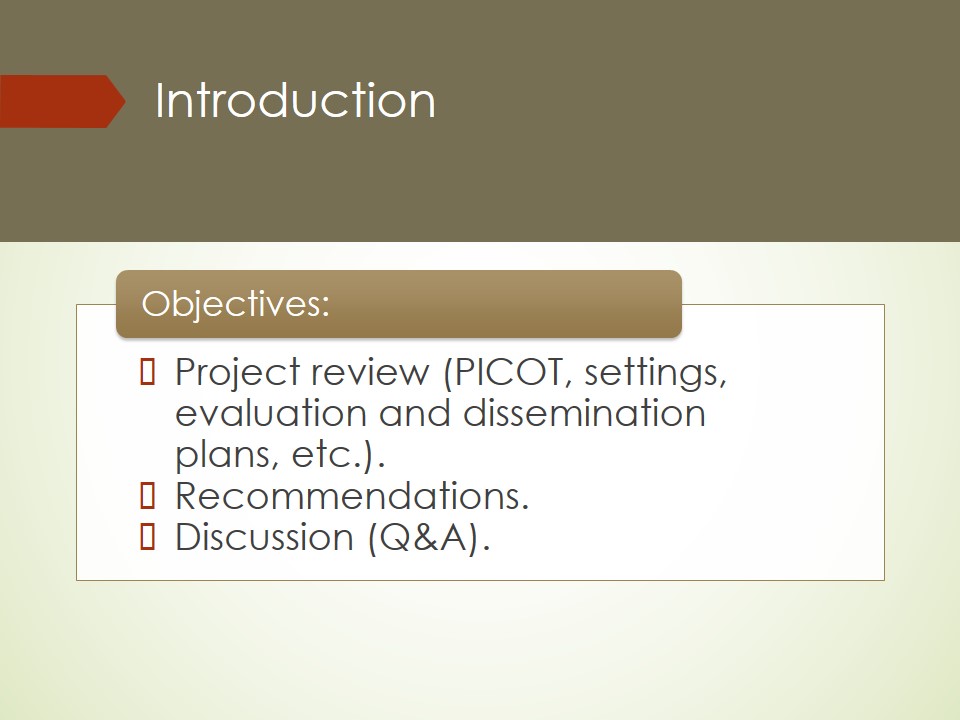
Project Purpose
- Depression: significant concern; 4.8% of the elderly population in the US (Center for Behavioral Health Statistics and Quality, 2016).
- Management: quality and efficiency issues (Petrosyan et al., 2017).
- Solution: management guidelines.
- VEGA: needs evidence-based guidelines.
Depression is a very significant health concern, which decreases the quality of life of patients, increases mortality, and requires notable healthcare expenditures (Petrosyan et al., 2017). This condition is also rather prevalent: for example, in 2016, 4.8% of the elderly population in the US experienced depression (Center for Behavioral Health Statistics and Quality, 2016). However, the reviews of depression management quality have demonstrated that it is often mismanaged with some patients remaining undertreated, which can be harmful, and others receiving too much treatment, which is not cost-efficient (Petrosyan et al., 2017). According to Petrosyan et al. (2017), the introduction of effective guidelines can resolve the issue. Since VEGA does not employ any standardized guidelines, it is difficult to ensure the quality of depression management in the center, which is why the introduction of evidence-based guidelines is recommended.
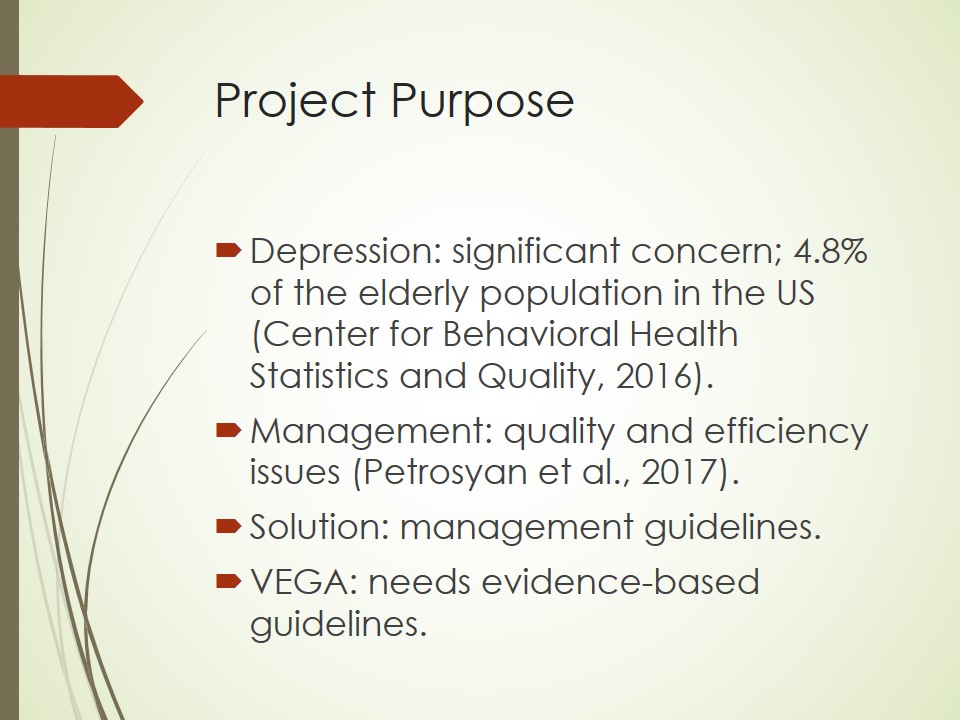
PICOT Question
In community clinic nursing staff, how does the introduction of the National Institute for Health and Care Excellence [NICE] (2016a) guidelines within ten weeks affect the accuracy of diagnosing and quality of managing depression in the older population as compared to the staff’s performance before the intervention?
As a result of these considerations, the presented PICOT question was developed. As you can see, the population of interest is the VEGA nursing staff working with elderly patients with depression. The intervention that was chosen for the project is the NICE (2016a) guidelines, which are evidence-based. The outcome is the changes in the quality of depression management as compared to the pre-intervention performance, and the timeframe amounts to ten weeks.
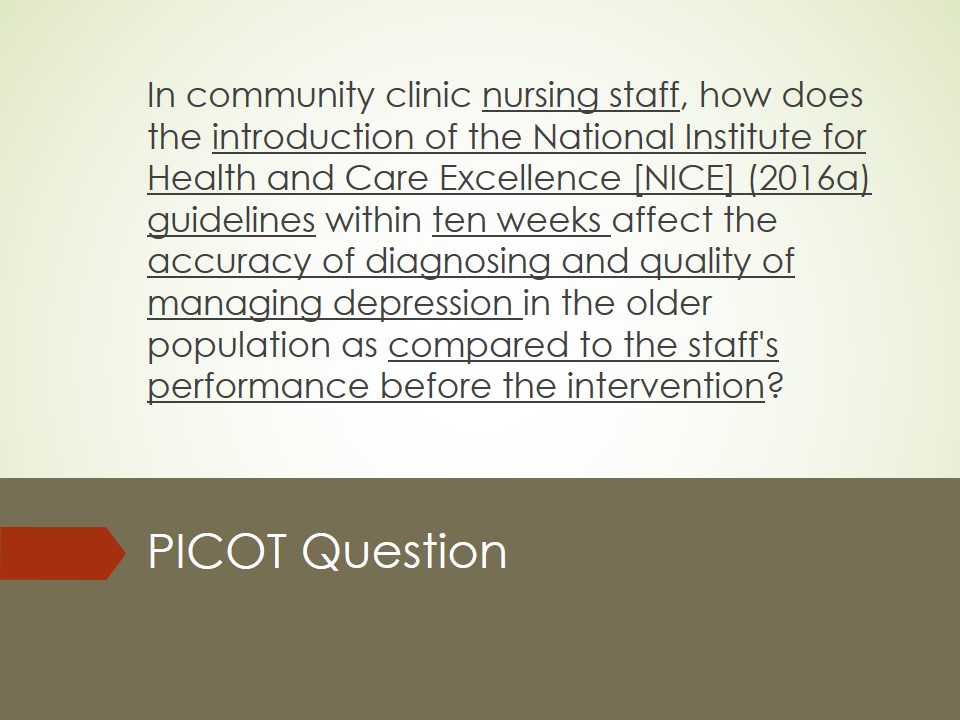
Project Setting
- VEGA Medical Center, Miami, FL: Family Medicine and Internal Medicine.
- Vision: healthier community.
- Mission: high-quality care.
- Prevalent customers: elderly population (diverse backgrounds).
- Sample: 10 nurses.
The VEGA Medical center is located in Miami, FL; it specializes in Family Medicine and Internal Medicine and aspires to improve the health of the diverse community that it serves by providing affordable and high-quality care. The elderly population with varied ethnic backgrounds constitutes the majority of VEGA’s patients, which highlights the importance of the proposed project for VEGA. The center’s administration approves of the project; as a result, it will be possible to recruit ten nurses from VEGA and arrange their participation.
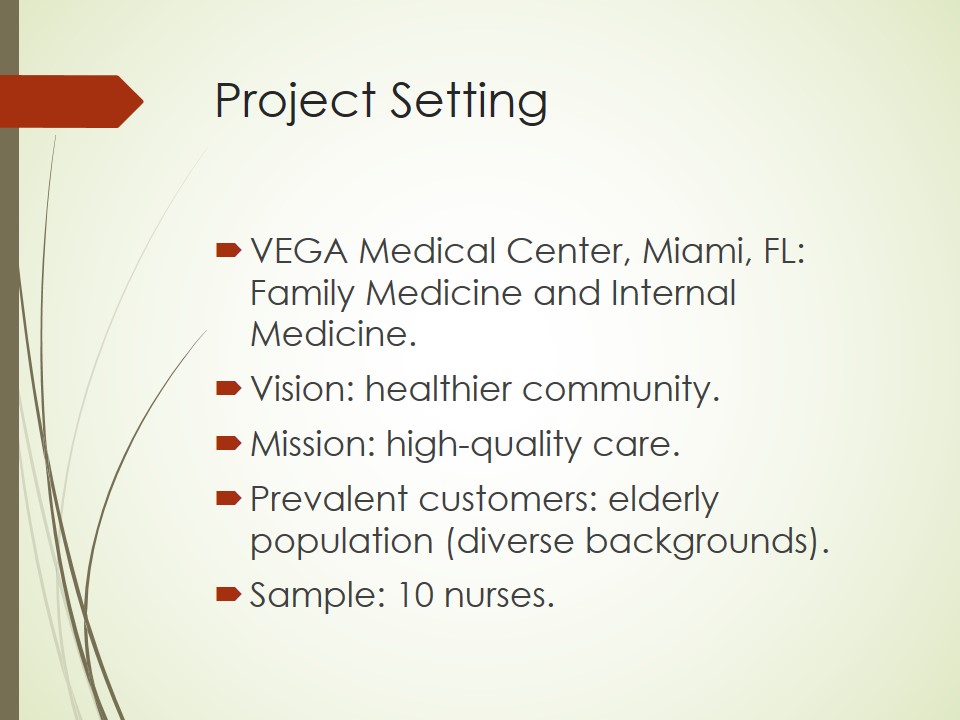
Project Description
- Facilitators: VEGA, nurses.
- Vision, mission: in line with VEGA.
- Barriers: timeframe, budget; change.
- Solution: planning.
- Solution: Iowa Model (IM) and Rogers’ (2010) theory (RT): compatible (Hanrahan et al., 2015).
The implementation of new guidelines should be facilitated by the fact that the project’s vision and mission are aligned with those of VEGA. In particular, the project aspires to ensure the delivery of optimal care to VEGA’s patients with depression by improving the quality of depression management, which is in line with VEGA’s efforts of providing best-quality care. Moreover, the organizational needs assessment shows that nurses are interested in the project, which ensures their support.
However, certain barriers are also present. The budget and timeframe of the project are rather constrained, although the careful planning of both will ensure their effective use. Furthermore, change is always a challenging process, which is why the project will employ a synthesis of two major change management models to ensure its success. In particular, the Iowa Model of Evidence-Based Practice and Rogers’ (2010) theory of innovation diffusion are going to be united to manage both the organizational and individual aspects of evidence-based practice introduction. As shown by Hanrahan et al. (2015), this synthesis is possible and can be a solution to the complex problem of change management.
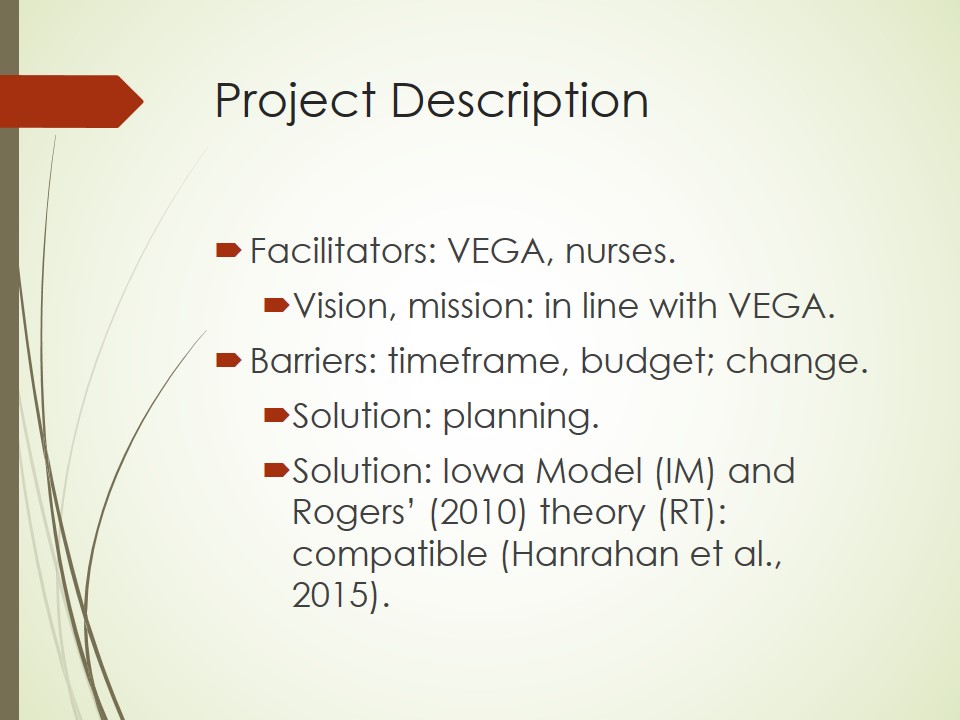
Evaluation and Dissemination Plans
- Summative evaluation: National Institute for Health and Care Excellence (2016b) quality standards.
- Formative evaluation: documentation, feedback.
- Qualitative and quantitative (ratio): thematic analysis and paired t-test.
- Internal dissemination (VEGA, educational institution).
The summative evaluation of the project will be carried out with the help of the depression management standards by the National Institute for Health and Care Excellence (2016b). The formative evaluation will track the process of adoption by documenting nurses’ depression management activities; also, nurses’ feedback will be solicited through extensive communication measures. The latter will be aimed at learning about the nurses’ familiarity with the guidelines and the issues and challenges that may be related to the change. All the nurses’ concerns will be addressed with VEGA’s support.
The evaluations will produce qualitative and quantitative data; the former will be analyzed with the help of thematic analysis, and the latter will be processed with the help of paired t-test.
Only internal dissemination is planned for the project: the final report will be provided to VEGA for tracking and evaluating the change; also, the report and the PowerPoint speech will be submitted to the educational institution as a part of the DNP project of the principal investigator.
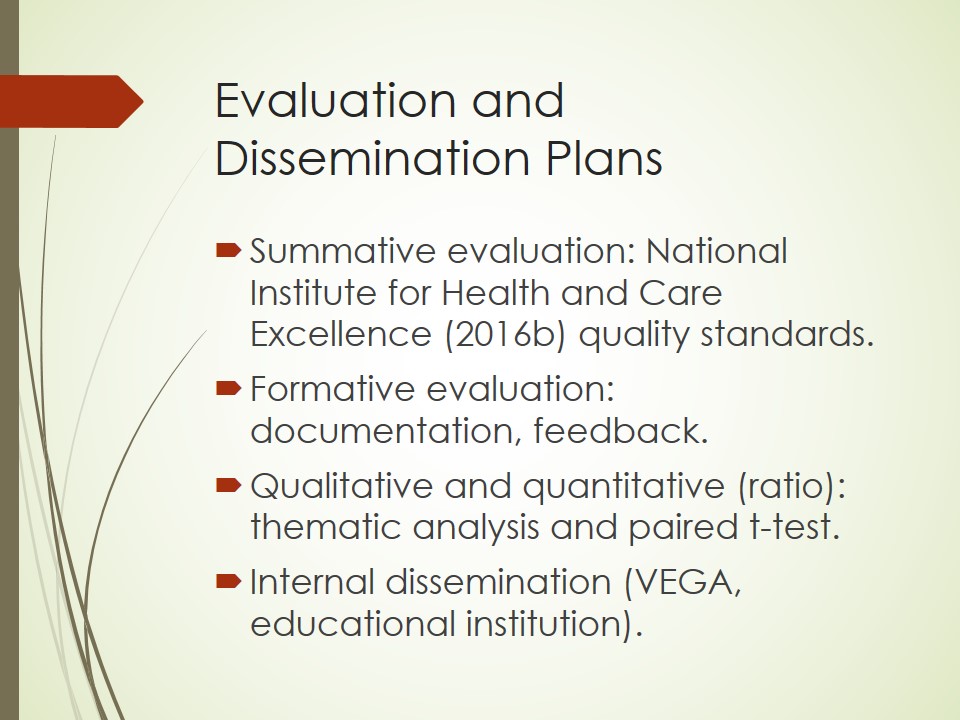
Project Description (Schedule)
- NR702: pre-implementation (IM).
- NR705: implementation (RT).
- NR707- NR709: evaluation, dissemination (IM).
The project will be carried out throughout NR702 and NR709. NR702 is devoted to the pre-implementation activities, including evidence collection and proposal development and approval. NR705 will involve the implementation phase, including the recruitment activities, the introduction of the new guidelines, and formative evaluation. The management of individual innovation adoption processes will be guided by Rogers’ (2010) theory. Finally, NR707 and NR709 will involve the summative assessment, the evaluation of the project, and dissemination activities. NR702, NR707, and NR709 will be guided by the Iowa model. In total, the implementation phase will take up ten weeks, and the whole project will last for about thirty weeks.
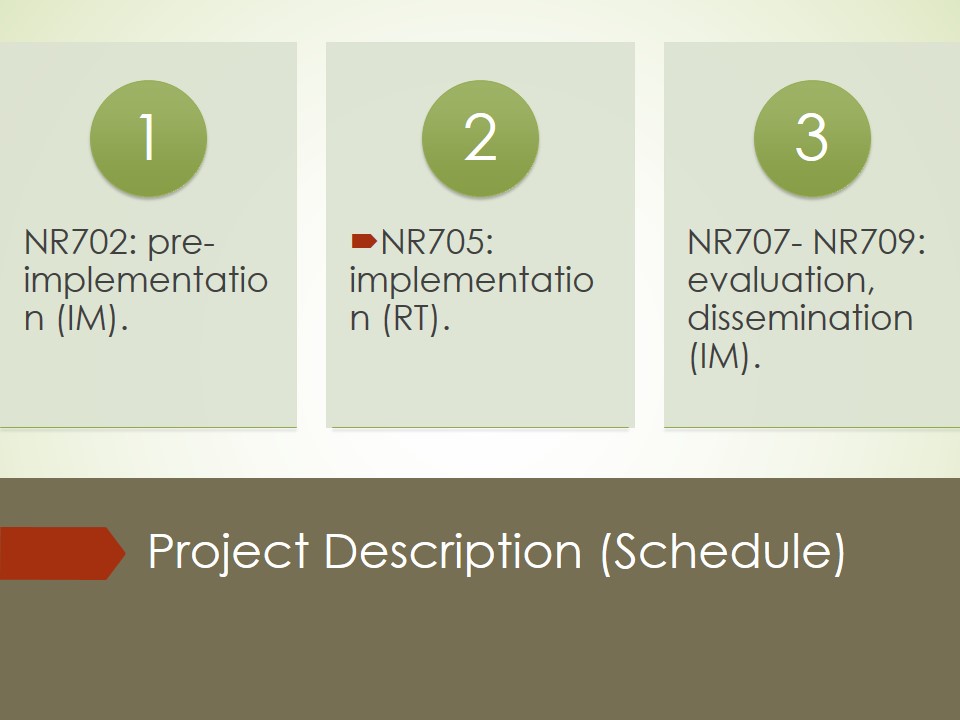
Conclusion
- Achieving objectives:
- Summary: NICE (2016a) guidelines for better depression management in VEGA.
- Recommendations: employing standard guidelines; merging IM and RT; aligning missions and visions of projects and settings.
- Q&A?
In summary, the VEGA center recognizes the need for standard guidelines, and the present project will help it in adopting appropriate ones for depression management. The fusion of two change models will assist in combating major change-related barriers and ensure the support of VEGA and its nurses, which, in turn, will further facilitate the process of guideline adoption. Therefore, the key lesson that can be learned from this project is the need for aligning various elements of projects to bring down barriers and develop facilitating features for better outcomes. You are welcome to ask any questions!
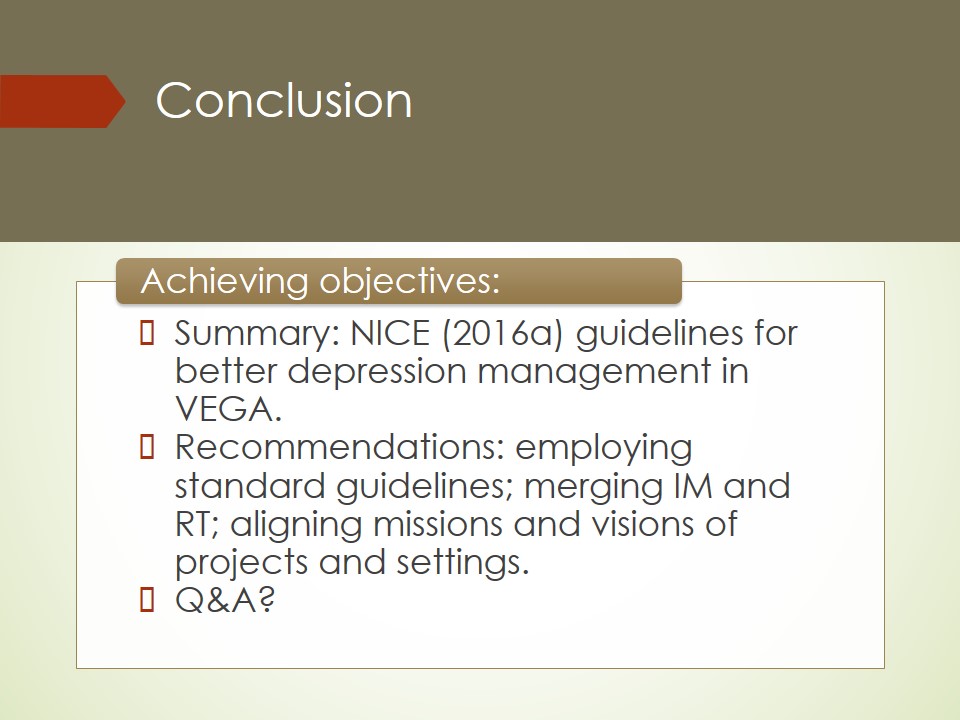
References
Center for Behavioral Health Statistics and Quality. (2016). Results from the 2015 national survey on drug use and health: Detailed tables. Web.
Hanrahan, K., Wagner, M., Matthews, G., Stewart, S., Dawson, C., Greiner, J., … Williamson, A. (2015). Sacred cow gone to pasture: A systematic evaluation and integration of evidence-based practice. Worldviews on Evidence-Based Nursing, 12(1), 3-11. Web.
National Institute for Health and Care Excellence. (2016a). Depression in adults: Recognition and management. Web.
National Institute for Health and Care Excellence. (2016b). Depression in adults: Quality Standards. Web.
Petrosyan, Y., Sahakyan, Y., Barnsley, J., Kuluski, K., Liu, B., & Wodchis, W. (2017). Quality indicators for care of depression in primary care settings: A systematic review. Systematic Reviews, 6(1), 1-14. Web.
Rogers, E.M. (2010). Diffusion of innovations (4th ed.). New York, NY: Simon and Schuster.